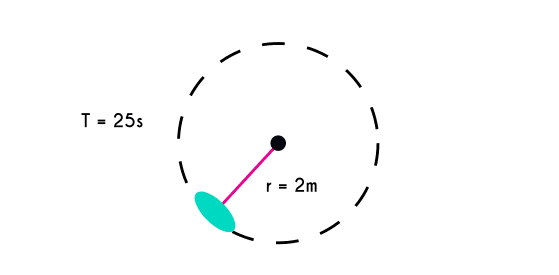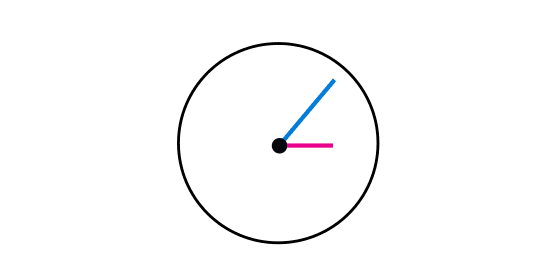Uniform circular motion explained with examples
This article will be about The uniform circular motion, definition, formulas and examples.
Uniform circular motion
The uniform circular motion, is a type of motion that has a circular trajectory (in a circle shape) and has a velocity that changes its direction constantly. We have to remember that the velocity is a vector magnitude, this means that it has a magnitude and a direction, and in a uniform circular motion, the magnitude of the vector is constant, what changes in the velocity vector is the direction, this is why, even though the magnitude is constant, we cannot say the velocity is constant as well.
In a uniformly circular motion there are two velocities and one acceleration, the acceleration, named centripetal acceleration, is the one that makes the direction of the velocity change all the time.
Even though in this motion are various physic magnitudes, this is pretty similar to a constant velocity motion, in uniformly circular motion problems that only include angular velocity, angle and time, the formulas to use are almost identical to the constant velocity motion formulas, the only changes in this formulas are the names of the variables.
The uniformly circular motion can be found in most of mechanisms, because the rotation is the main part of an engine and in most of the components of many gadgets, this motion can be found in the behavior of particles.

Uniform circular motion concepts
In a uniformly circular motion there are more magnitudes than in other kinematic studies, like different types of velocities, accelerations and angles, and when we solve uniformly circular motion problems, we are going to find all kind of magnitudes, so it is important to know what is each magnitude, and how this magnitude affects the behavior of the object.
Centripetal acceleration: this acceleration does not affects the magnitude of the velocity, the centripetal acceleration makes that the direction of the velocity changes constantly, this is the reason why this motion is in circle.
Angular velocity is the velocity at which an object rotates. This velocity is the relation between angles or radians that a body rotates and a period of time, for example, if an object turns around a center one time every hour, then the angular velocity is 360°/h. The standard units of measure of the angular velocity are radians and seconds, although we can use other units, but in general (and in this article) we are going to use radians and seconds.
Tangential velocity: is the relation between the longitude that an object covers and a period of time, this is the velocity we can find in rectilinear motion, it can be expressed in miles per hour, kilometers per hour, and meters per second. In this article we are going to be using meters per hour as our standard unit.
Period: is represented by a capital “T”, and is the time that an object takes to turn around once, this is a time unit, so it is measured in seconds.
Frequency: it is the amount of turns that an object makes in a determined time, in general the time is in seconds. The frequency is represented by the letter “f” and it is expressed in Hertz (hz).
Period and frequency: This two magnitudes are reciprocal, this means that when we multiply them, the result is going to be 1, this is useful to define the uniform circular motion formulas.
Uniform circular motion Formulas
In a circular motion we can see 2 different types of environments, the angular and the tangential, the angular is everything that has to do with angles and rotation, and the tangential is everything that has to do with distances. This two parts of the circular motion can be worked separately, but this are deeply connected, we can change the environment by knowing the radius.
There are many formulas, this is why it is so important to learn what is every magnitude, so we can know which formula to use in every occasion.
- Basic formulas
- Θ = ω * t
- ω = Θ / t
- t = Θ / ω
- Frequence and period formulas
- T = timeturns
- T = 1f
- f = turnstime
- f = 1T
- Tangetial velocity(Vt)
- Vt = 2 * π RT
- Vt = 2 * π * R * f
- Angular velocity(ω)
- ω = 2 * π T
- ω = 2 * π * f
- Centripetal acceleration
- Ac = Vt2R
- Ac = ω2 * R
- Convert angular velocity into tangetial velocity
- ω = VtR
- Vt = ω * R
Uniform circular motion examples
Example 1: A horse in a carousel takes 25 seconds to complete a turn, if we know that the distance between the center of the carousel and the horse is of 2 meters, calculate the tangential velocity of the horse.

In this problem there are two data, the period T = 25s and the ratio r=2m, so we are going to use the formula of the tangential velocity with the period, in this case all the data are in meters and seconds so we do not have to convert any data.
- Vt = 2 * π * RT
- Vt = 2 * 3.1416 * 225
- Vt = 12.5725
- Vt = 0.502 m/s
Example 2: What is the angular velocity of the blades of a fan if we know that the fan turns 200 times per minute.

In this case there is no data that we can use directly in the formulas, but with the data we have we can find either the period or the frequency and with this we can calculate the angular velocity.
- First we convert the minutes in seconds
- Time = 1min
- Time (seconds) = 1min * 60 seconds
- Time (seconds) = 60 seconds
- Now we calculate the frequency
- f = turnstime
- f = 20060
- f = 3.33 hz
Now knowing the frequency we can calculate the angular velocity
- Angular velocity equation
- ω = 2 * π * f
- ω = 2 * 3.1416 * 3.33
- ω = 20.92 rad/s
Example 3: Calculate the centripetal acceleration that has the tip of the second hand clock, knowing that the hand is 7 centimeters long.

In this example there are two data, one of them is the radius, because the second hand clock is 7 cm and like this goes from the center to the tip of the hand, this is equals to the radius of the circle, and another thing we know is that the tip turn one time every 60 seconds, this is the period.
- First we convert the meters into centimeters
- R (mt) = 7cm / 100 cm/mt
- R (mt) = 0.07m
- T = 60s
Now we are going to find the angular velocity so we can calculate the centripetal acceleration.
- now we calculate the angular velocity
- ω = 2 * πT
- ω = 2 * 3.141660
- ω = 6.2860
- ω = 0.105 rad/s
And finally we can find the centripetal acceleration.
- We find the centripetal acceleration
- Ac = ω2R
- Ac = 0.10520.07m
- Ac = 0.0110.07m
- Ac = 0.157